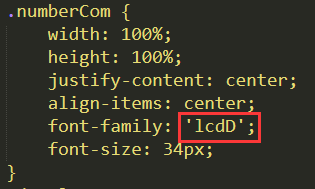vue学习笔记
以后都从上往下加了
vue cli2.9配置全局变量 该方法适用于改变整个项目的通用名称,还可以在vuex里配置全局变量,两个全局变量使用的意义不同。
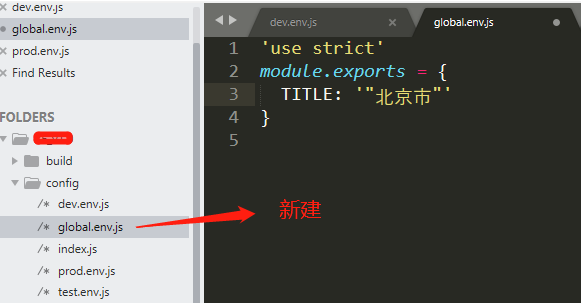
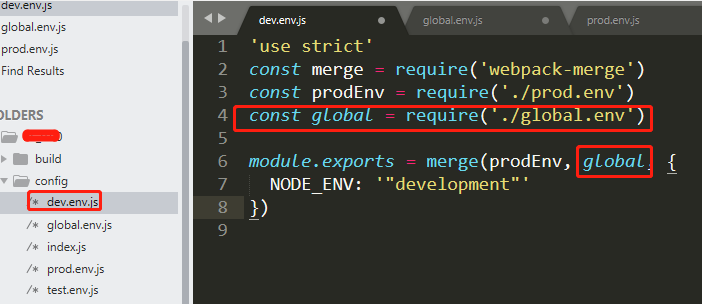
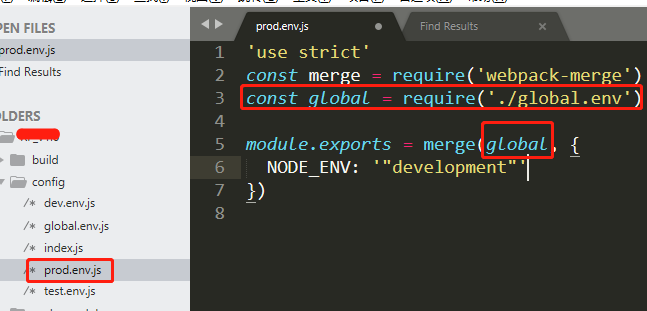
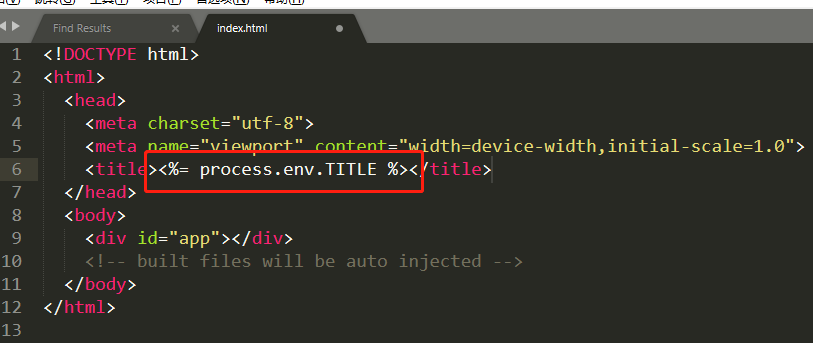
vue cli3.0配置全局变量
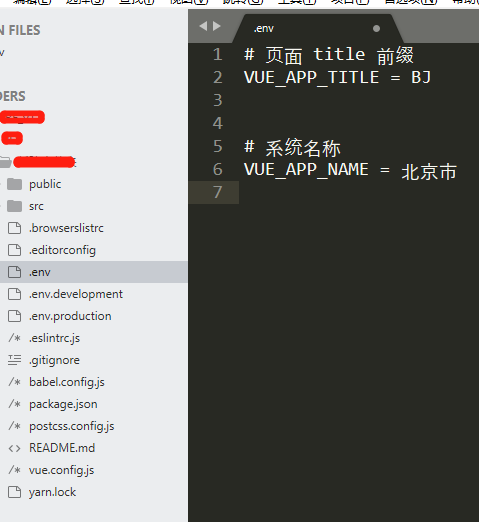

1、 cnpm run dev之后希望自动打开浏览器地址
将config下index.js的autoOpenBrowser改为true
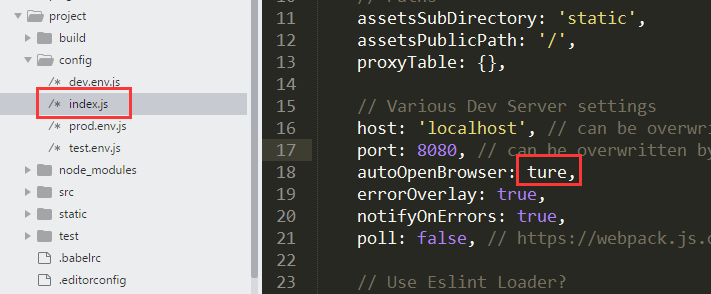
2、项目中配置的config/index.js,有dev和production两种环境的配置 以下介绍的是production环境下的webpack配置的理解
// see http://vuejs-templates.github.io/webpack for documentation.
var path = require('path')
var projectName = 'dist';
module.exports = {
build: {
// webpack的编译环境
env: require('./prod.env'),
// 编译输入的index.html文件
// __dirname代表当前的目录,config, path.resolve拼接起来就是
// 从config返回上一级,然后进入${projectName}目录,比如dist,然后输出为dist下的index.html
index: path.resolve(__dirname, `../${projectName}/index.html`),
// 编译完成的项目根目录
assetsRoot: path.resolve(__dirname, `../${projectName}`),
// 静态文件目录
assetsSubDirectory: 'static',
// 引入css,js时的路径,相对于html页面,为空,所以打包以后路径为:static/js/xxx.js
// 这样项目内部都是相对路径,项目文件夹改名不需要重新打包。
assetsPublicPath: '',
productionSourceMap: true,
// Gzip off by default as many popular static hosts such as
// Surge or Netlify already gzip all static assets for you.
// Before setting to `true`, make sure to:
// npm install --save-dev compression-webpack-plugin
productionGzip: false,
productionGzipExtensions: ['js', 'css'],
// Run the build command with an extra argument to
// View the bundle analyzer report after build finishes:
// `npm run build --report`
// Set to `true` or `false` to always turn it on or off
bundleAnalyzerReport: process.env.npm_config_report
},
dev: {
env: require('./dev.env'),
port: 8989,
autoOpenBrowser: true,
assetsSubDirectory: 'static',
assetsPublicPath: '/',
proxyTable: {
'/map': {
target: "http://172.11.11.111:8080/",
changeOrigin: true
},
'/web/': {
target: 'http://172.22.22.22:8080',
changeOrigin: true
}
},
// CSS Sourcemaps off by default because relative paths are "buggy"
// with this option, according to the CSS-Loader README
// (https://github.com/webpack/css-loader#sourcemaps)
// In our experience, they generally work as expected,
// just be aware of this issue when enabling this option.
cssSourceMap: false
}
}
vue中的build/webpack.base.conf.js(这里需要配置)
/*
1 配置 webpack 编译入口
2 配置 webpack 输出路径和命名规则
3 配置模块 resolve 规则
4 配置不同类型模块的处理规则
*/
var path = require('path')
var utils = require('./utils')
var config = require('../config') // 获取配置
// vue-loader 配置文件
var vueLoaderConfig = require('./vue-loader.conf')
// 给出正确的绝对路径
function resolve(dir) {
return path.join(__dirname, '..', dir)
}
module.exports = {
// 配置 webpack 编译入口
entry: {
app: './src/main.js'
},
// 配置 webpack 输出路径和命名规则
output: {
// webpack 输出的目标文件夹路径(例如:/dist)
path: config.build.assetsRoot,
// webpack 输出 bundle 文件命名格式
filename: '[name].js',
// webpack 编译输出的发布路径
publicPath: process.env.NODE_ENV === 'production' ?
config.build.assetsPublicPath :
config.dev.assetsPublicPath
},
externals: { // 如果需要依赖jquery,这里要配置下
jquery: 'jQuery'
},
// 配置模块 resolve 的规则,当省略文件后缀名时按配置的后缀顺序查找文件
resolve: {
extensions: ['.js', '.vue', '.json'], //自动解析确定的拓展名,使导入模块时不带拓展名
// 创建路径别名,一些常用的,路径长的都可以用别名,有了别名之后引用模块更方便,例如
// import Vue from 'vue/dist/vue.common.js'可以写成 import Vue from 'vue'
alias: {
'vue$': 'vue/dist/vue.esm.js',
'@': resolve('src'),
'example': resolve('example'),
'components': '@/components', //从这往下对应src里的文件夹,这里需要配置
'common': '@/common',
'router': '@/router',
'store': '@/store',
'api': '@/api',
'assets': '@/assets',
'constant': '@/constant',
'views': '@/views',
'utils': '@/utils'
}
},
module: {
rules: [{
test: /\.(js|vue)$/,
loader: 'eslint-loader',
enforce: 'pre',
include: [resolve('src'), resolve('test')],
options: {
formatter: require('eslint-friendly-formatter')
}
},
{
test: /\.vue$/,
loader: 'vue-loader',
options: vueLoaderConfig
},
{
test: /\.js$/,
loader: 'babel-loader',
include: [resolve('src'), resolve('test')]
},
{
test: /\.(png|jpe?g|gif|svg)(\?.*)?$/,
loader: 'url-loader',
options: {
limit: 10000,
name: utils.assetsPath('img/[name].[hash:7].[ext]')
}
},
{
test: /\.(mp4|webm|ogg|mp3|wav|flac|aac)(\?.*)?$/,
loader: 'url-loader',
options: {
limit: 10000,
name: utils.assetsPath('media/[name].[hash:7].[ext]')
}
},
{
test: /\.(woff2?|eot|ttf|otf)(\?.*)?$/,
loader: 'url-loader',
options: {
limit: 10000,
name: utils.assetsPath('fonts/[name].[hash:7].[ext]')
}
}
]
}
}
webpack.prod.conf.js 生产环境下的配置文件(看看就行,不用配置)
'use strict'
const path = require('path')
const utils = require('./utils')
const webpack = require('webpack')
const config = require('../config')
const merge = require('webpack-merge') // 一个可以合并数组和对象的插件
const baseWebpackConfig = require('./webpack.base.conf')
// 用于从webpack生成的bundle中提取文本到特定文件中的插件
// 可以抽取出css,js文件将其与webpack输出的bundle分离
const CopyWebpackPlugin = require('copy-webpack-plugin')
const HtmlWebpackPlugin = require('html-webpack-plugin') // 一个用于生成HTML文件并自动注入依赖文件(link/script)的webpack插件
const ExtractTextPlugin = require('extract-text-webpack-plugin') //如果我们想用webpack打包成一个文件,css js分离开,需要这个插件
const OptimizeCSSPlugin = require('optimize-css-assets-webpack-plugin')
const UglifyJsPlugin = require('uglifyjs-webpack-plugin')
const env = process.env.NODE_ENV === 'testing'
? require('../config/test.env')
: require('../config/prod.env')
// 合并基础的webpack配置
const webpackConfig = merge(baseWebpackConfig, {
// 配置样式文件的处理规则,使用styleLoaders
module: {
rules: utils.styleLoaders({
sourceMap: config.build.productionSourceMap,
extract: true,
usePostCSS: true
})
},
devtool: config.build.productionSourceMap ? config.build.devtool : false,// 开启source-map,生产环境下推荐使用cheap-source-map或source-map,后者得到的.map文件体积比较大,但是能够完全还原以前的js代码
output: {
path: config.build.assetsRoot,// 编译输出目录
filename: utils.assetsPath('js/[name].[chunkhash].js'),// 编译输出文件名格式
chunkFilename: utils.assetsPath('js/[id].[chunkhash].js')// 没有指定输出名的文件输出的文件名格式
},
// 重新配置插件项
plugins: [
// http://vuejs.github.io/vue-loader/en/workflow/production.html
// 位于开发环境下
new webpack.DefinePlugin({
'process.env': env
}),
new UglifyJsPlugin({
uglifyOptions: {
compress: {
warnings: false
}
},
sourceMap: config.build.productionSourceMap,
parallel: true
}),
// extract css into its own file
new ExtractTextPlugin({
filename: utils.assetsPath('css/[name].[contenthash].css'),// 抽离css文件
// Setting the following option to `false` will not extract CSS from codesplit chunks.
// Their CSS will instead be inserted dynamically with style-loader when the codesplit chunk has been loaded by webpack.
// It's currently set to `true` because we are seeing that sourcemaps are included in the codesplit bundle as well when it's `false`,
// increasing file size: https://github.com/vuejs-templates/webpack/issues/1110
allChunks: true,
}),
// Compress extracted CSS. We are using this plugin so that possible
// duplicated CSS from different components can be deduped.
// filename 生成网页的HTML名字,可以使用/来控制文件文件的目录结构,最终生成的路径是基于webpac配置的output.path的
new OptimizeCSSPlugin({
cssProcessorOptions: config.build.productionSourceMap
? { safe: true, map: { inline: false } }
: { safe: true }
}),
// generate dist index.html with correct asset hash for caching.
// you can customize output by editing /index.html
// see https://github.com/ampedandwired/html-webpack-plugin
new HtmlWebpackPlugin({
// 生成html文件的名字,路径和生产环境下的不同,要与修改后的publickPath相结合,否则开启服务器后页面空白
filename: process.env.NODE_ENV === 'testing'
? 'index.html'
: config.build.index,
// 源文件,路径相对于本文件所在的位置
template: 'index.html',
inject: true, // 要把<script>标签插入到页面哪个标签里(body|true|head|false)
minify: {
removeComments: true,
collapseWhitespace: true,
removeAttributeQuotes: true
// more options:
// https://github.com/kangax/html-minifier#options-quick-reference
},
// necessary to consistently work with multiple chunks via CommonsChunkPlugin
chunksSortMode: 'dependency'
}),
// keep module.id stable when vender modules does not change
new webpack.HashedModuleIdsPlugin(),
// enable scope hoisting
new webpack.optimize.ModuleConcatenationPlugin(),
// split vendor js into its own file
new webpack.optimize.CommonsChunkPlugin({
name: 'vendor',
minChunks (module) {
// any required modules inside node_modules are extracted to vendor
return (
module.resource &&
/\.js$/.test(module.resource) &&
module.resource.indexOf(
path.join(__dirname, '../node_modules')
) === 0
)
}
}),
// extract webpack runtime and module manifest to its own file in order to
// prevent vendor hash from being updated whenever app bundle is updated
new webpack.optimize.CommonsChunkPlugin({
name: 'manifest',
minChunks: Infinity
}),
// This instance extracts shared chunks from code splitted chunks and bundles them
// in a separate chunk, similar to the vendor chunk
// see: https://webpack.js.org/plugins/commons-chunk-plugin/#extra-async-commons-chunk
new webpack.optimize.CommonsChunkPlugin({ // 为组件分配ID,通过这个插件webpack可以分析和优先考虑使用最多的模块,并为它们分配最小的ID
name: 'app',
async: 'vendor-async',
children: true,
minChunks: 3
}),
// copy custom static assets
new CopyWebpackPlugin([
{
from: path.resolve(__dirname, '../static'),
to: config.build.assetsSubDirectory,
ignore: ['.*']
}
])
]
})
// gzip模式下需要引入compression插件进行压缩
if (config.build.productionGzip) {
const CompressionWebpackPlugin = require('compression-webpack-plugin')
webpackConfig.plugins.push(
new CompressionWebpackPlugin({
asset: '[path].gz[query]',
algorithm: 'gzip',
test: new RegExp(
'\\.(' +
config.build.productionGzipExtensions.join('|') +
')$'
),
threshold: 10240,
minRatio: 0.8
})
)
}
if (config.build.bundleAnalyzerReport) {
const BundleAnalyzerPlugin = require('webpack-bundle-analyzer').BundleAnalyzerPlugin
webpackConfig.plugins.push(new BundleAnalyzerPlugin())
}
module.exports = webpackConfig
vue 中build/build.js页(看看就行,基本不用配置)
require('./check-versions')() // 检查 Node 和 npm 版本
// 标明现在是生产环境
process.env.NODE_ENV = 'production'
var ora = require('ora') // 一个很好看的 loading 插件
var rm = require('rimraf')
var path = require('path')
var chalk = require('chalk')
var webpack = require('webpack')
var config = require('../config') // 加载 config.js
var webpackConfig = require('./webpack.prod.conf')
var spinner = ora('开始打包生产环境代码,请稍后...') // 使用 ora 打印出 loading + log
spinner.start() // 开始 loading 动画
// 首先删除 打包后文件夹的内容,然后回调函数里面调用 webpack 开始打包
rm(path.join(config.build.assetsRoot, config.build.assetsSubDirectory), err => {
if (err) throw err
webpack(webpackConfig, function (err, stats) { // 开始 webpack 的编译
// 编译成功的回调函数
spinner.stop()
if (err) throw err
process.stdout.write(stats.toString({
colors: true,
modules: false,
children: false,
chunks: false,
chunkModules: false
}) + '\n\n')
if (stats.hasErrors()) {
console.log(chalk.red(' 构建失败,出现错误!\n'))
process.exit(1)
}
console.log(chalk.cyan(' 打包完成!!!.\n'))
console.log(chalk.yellow(
' 文件需要在服务端打开。\n' +
' 以file:// index.html这种形式打开不起作用\n'
))
})
})
3、vue 中 BEM样式失效
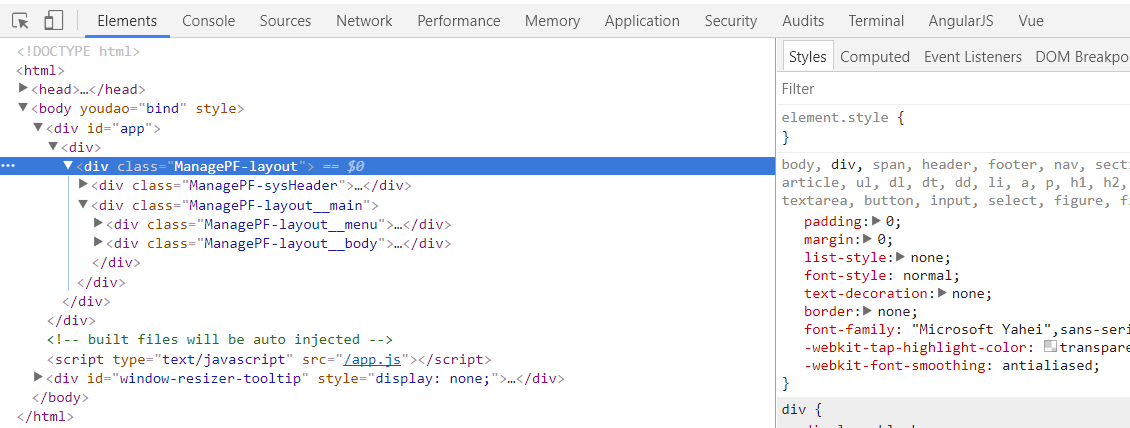
发现是postcss.js没有配置,需要这样配置下
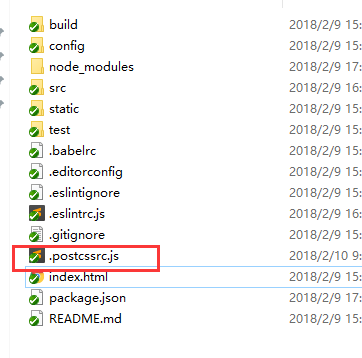
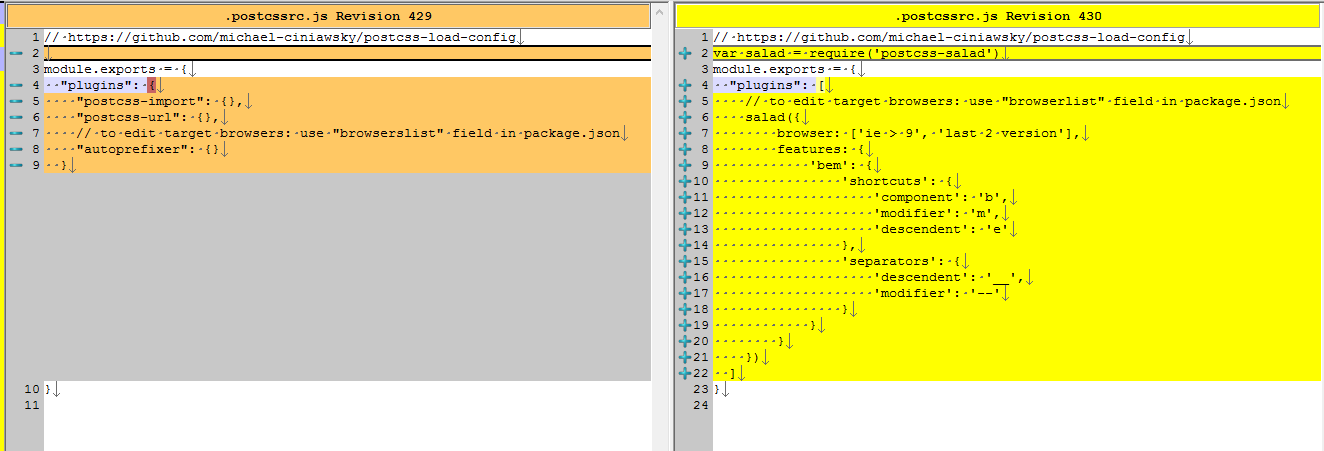
// https://github.com/michael-ciniawsky/postcss-load-config
var salad = require('postcss-salad')
module.exports = {
"plugins": [
// to edit target browsers: use "browserlist" field in package.json
salad({
browser: ['ie > 9', 'last 2 version'],
features: {
'bem': {
'shortcuts': {
'component': 'b',
'modifier': 'm',
'descendent': 'e'
},
'separators': {
'descendent': '__',
'modifier': '--'
}
}
}
})
]
}
还需要在package.json里安装
"postcss": "^5.2.17",
"postcss-salad": "^1.0.8",

4、一些语法的使用

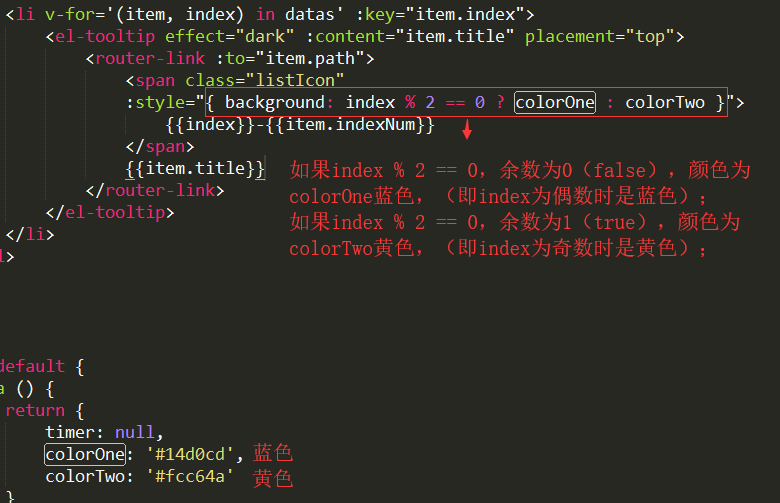

5、各css背景图片
BEM

postcss


less


module



6、自定义点击事件


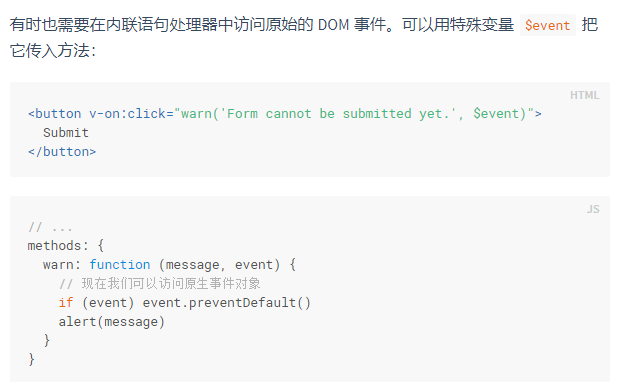
7、自定义字体
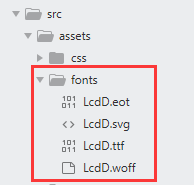
注入css
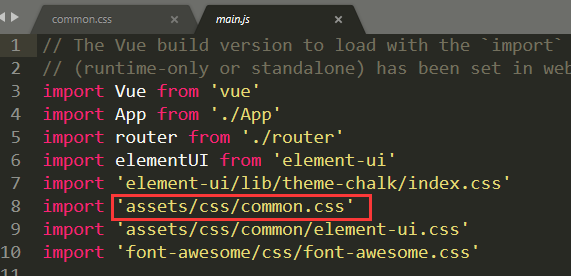
@font-face { font-family: 'lcdD'; src: url('~assets/fonts/lcdD.eot'); src: url('~assets/fonts/lcdD.eot?font-spider') format('embedded-opentype'), url('~assets/fonts/lcdD.woff') format('woff'), url('~assets/fonts/lcdD.ttf') format('truetype'), url('~assets/fonts/lcdD.svg') format('svg'); font-weight: normal; font-style: normal; }
